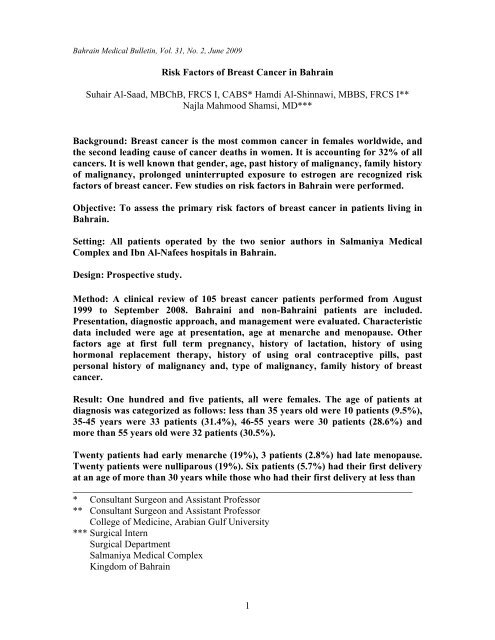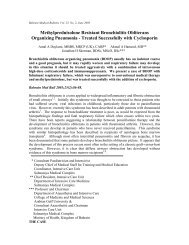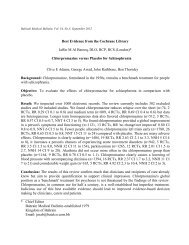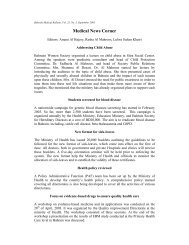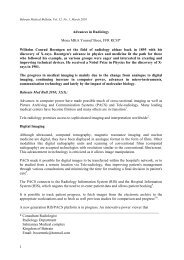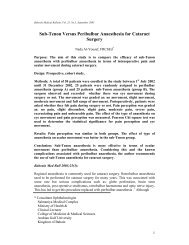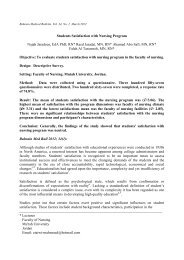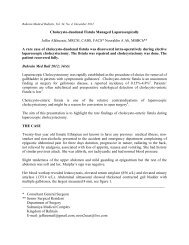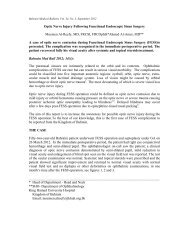Risk factors of Breast Cancer in Bahrain - Bahrain Medical Bulletin
Risk factors of Breast Cancer in Bahrain - Bahrain Medical Bulletin
Risk factors of Breast Cancer in Bahrain - Bahrain Medical Bulletin
Create successful ePaper yourself
Turn your PDF publications into a flip-book with our unique Google optimized e-Paper software.
Bahra<strong>in</strong> <strong>Medical</strong> Bullet<strong>in</strong>, Vol. 31, No. 2, June 2009<br />
<strong>Risk</strong> Factors <strong>of</strong> <strong>Breast</strong> <strong>Cancer</strong> <strong>in</strong> Bahra<strong>in</strong><br />
Suhair Al-Saad, MBChB, FRCS I, CABS* Hamdi Al-Sh<strong>in</strong>nawi, MBBS, FRCS I**<br />
Najla Mahmood Shamsi, MD***<br />
Background: <strong>Breast</strong> cancer is the most common cancer <strong>in</strong> females worldwide, and<br />
the second lead<strong>in</strong>g cause <strong>of</strong> cancer deaths <strong>in</strong> women. It is account<strong>in</strong>g for 32% <strong>of</strong> all<br />
cancers. It is well known that gender, age, past history <strong>of</strong> malignancy, family history<br />
<strong>of</strong> malignancy, prolonged un<strong>in</strong>terrupted exposure to estrogen are recognized risk<br />
<strong>factors</strong> <strong>of</strong> breast cancer. Few studies on risk <strong>factors</strong> <strong>in</strong> Bahra<strong>in</strong> were performed.<br />
Objective: To assess the primary risk <strong>factors</strong> <strong>of</strong> breast cancer <strong>in</strong> patients liv<strong>in</strong>g <strong>in</strong><br />
Bahra<strong>in</strong>.<br />
Sett<strong>in</strong>g: All patients operated by the two senior authors <strong>in</strong> Salmaniya <strong>Medical</strong><br />
Complex and Ibn Al-Nafees hospitals <strong>in</strong> Bahra<strong>in</strong>.<br />
Design: Prospective study.<br />
Method: A cl<strong>in</strong>ical review <strong>of</strong> 105 breast cancer patients performed from August<br />
1999 to September 2008. Bahra<strong>in</strong>i and non-Bahra<strong>in</strong>i patients are <strong>in</strong>cluded.<br />
Presentation, diagnostic approach, and management were evaluated. Characteristic<br />
data <strong>in</strong>cluded were age at presentation, age at menarche and menopause. Other<br />
<strong>factors</strong> age at first full term pregnancy, history <strong>of</strong> lactation, history <strong>of</strong> us<strong>in</strong>g<br />
hormonal replacement therapy, history <strong>of</strong> us<strong>in</strong>g oral contraceptive pills, past<br />
personal history <strong>of</strong> malignancy and, type <strong>of</strong> malignancy, family history <strong>of</strong> breast<br />
cancer.<br />
Result: One hundred and five patients, all were females. The age <strong>of</strong> patients at<br />
diagnosis was categorized as follows: less than 35 years old were 10 patients (9.5%),<br />
35-45 years were 33 patients (31.4%), 46-55 years were 30 patients (28.6%) and<br />
more than 55 years old were 32 patients (30.5%).<br />
Twenty patients had early menarche (19%), 3 patients (2.8%) had late menopause.<br />
Twenty patients were nulliparous (19%). Six patients (5.7%) had their first delivery<br />
at an age <strong>of</strong> more than 30 years while those who had their first delivery at less than<br />
______________________________________________________________________<br />
* Consultant Surgeon and Assistant Pr<strong>of</strong>essor<br />
** Consultant Surgeon and Assistant Pr<strong>of</strong>essor<br />
College <strong>of</strong> Medic<strong>in</strong>e, Arabian Gulf University<br />
*** Surgical Intern<br />
Surgical Department<br />
Salmaniya <strong>Medical</strong> Complex<br />
K<strong>in</strong>gdom <strong>of</strong> Bahra<strong>in</strong><br />
1
30 years <strong>of</strong> age were 79 patients (75.2%). Lactation history was negative <strong>in</strong> 27<br />
patients (25.7%). Twenty-one patients (20%) used Oral Contraceptive Pills (OCP)<br />
for long periods. Two patients (1.9%) only were on Hormonal Replacement<br />
Therapy (HRT). Two patients (1.9%) had positive past personal history <strong>of</strong><br />
malignancy (breast and ovaries). Twenty-two patients (20.9%) had positive family<br />
history <strong>of</strong> breast cancer.<br />
Conclusion: Almost 70% <strong>of</strong> our patients were below or equal to 55 years at<br />
presentation. Family history was found significantly higher <strong>in</strong> our patients (20.9%).<br />
Bahra<strong>in</strong> Med Bull 2009; 31(2):<br />
<strong>Breast</strong> cancer is unlike lung cancer, <strong>in</strong> which smok<strong>in</strong>g is the primary cause. <strong>Breast</strong> cancer<br />
has large number <strong>of</strong> epidemiological <strong>factors</strong> which will <strong>in</strong>crease the risk.<br />
These risk <strong>factors</strong> could provide important clues to the etiology <strong>of</strong> breast cancer.<br />
Advanc<strong>in</strong>g age is one <strong>of</strong> the most important <strong>factors</strong>. It was found that breast cancer<br />
<strong>in</strong>cidence and death rates generally <strong>in</strong>crease with age. From 2001-2005, the median age<br />
at diagnosis for breast cancer <strong>in</strong> US females was 61 years <strong>of</strong> age. Approximately 0.0%<br />
was diagnosed under age 20, 1.9% between 20 and 34, 10.6% between 35 and 44, 22.4%<br />
between 45 and 54, 23.3% between 55 and 64, 19.8% between 65 and 74, 16.5% between<br />
75 and 84 and f<strong>in</strong>ally 5.5% <strong>in</strong> 85 years <strong>of</strong> age and above 1 .<br />
Personal history <strong>of</strong> previous breast cancer is a risk factor for cancer recurrence or the<br />
development <strong>of</strong> a new primary breast cancer, the risk is 19% accord<strong>in</strong>g to the study by<br />
Hiramanek 2 .<br />
The probability <strong>of</strong> a woman aged 20 years to develop breast cancer by the age <strong>of</strong> 80 with no<br />
affected relatives is 7.8%, with one affected relative is 13.3% and with two affected relatives<br />
is 21.1% 3,4 .<br />
The prolonged un<strong>in</strong>terrupted exposure to estrogens such as early menarche, late<br />
menopause, nulliparity, late pregnancy (after the age <strong>of</strong> 30), absence <strong>of</strong> history <strong>of</strong><br />
lactation, the use <strong>of</strong> hormonal replacement therapy (HRT), the use <strong>of</strong> oral contraceptive<br />
pills (OCPs) are considered risk <strong>factors</strong> 5 .<br />
Other environmental <strong>factors</strong> such as alcohol <strong>in</strong>take and exposure to radiation may play a<br />
role 5 .<br />
Aetiology is unknown <strong>in</strong> 95% <strong>of</strong> breast cancer cases, while approximately 5% <strong>of</strong> new<br />
breast cancers are attributable to hereditary <strong>factors</strong>. Carriers <strong>of</strong> the breast cancer<br />
susceptibility genes (BRCA1 and BRCA2) are at 30-40% <strong>in</strong>creased risk for breast and<br />
ovarian cancer 6,7,8 .<br />
Another study confirmed that <strong>in</strong>creased risk <strong>of</strong> develop<strong>in</strong>g breast cancer at an earlier age<br />
was seen <strong>in</strong> those who are hav<strong>in</strong>g family history <strong>of</strong> breast cancer. The mutation <strong>in</strong><br />
BRCA1 and BRCA2 might expla<strong>in</strong> these f<strong>in</strong>d<strong>in</strong>gs 9,10 .<br />
2
The aim <strong>of</strong> this study is to assess the primary risk <strong>factors</strong> <strong>of</strong> breast cancer.<br />
METHOD<br />
Dur<strong>in</strong>g the last n<strong>in</strong>e years (August 1999 and September 2008) one hundred and five<br />
breast cancer patients were diagnosed, operated and followed up by the senior authors.<br />
Presentation, diagnostic approach, and management were evaluated. Age at presentation,<br />
age at menarche and menopause were recorded. The risk <strong>factors</strong>, such as parity, age at<br />
first full term pregnancy, history <strong>of</strong> lactation, history <strong>of</strong> us<strong>in</strong>g hormonal replacement<br />
therapy, history <strong>of</strong> us<strong>in</strong>g oral contraceptive pills, past personal history <strong>of</strong> malignancy and<br />
type <strong>of</strong> malignancy, family history <strong>of</strong> breast cancer or other related malignancy were<br />
recorded.<br />
This data was recorded prospectively for almost all <strong>of</strong> our patients.<br />
This study is cont<strong>in</strong>uation and follow up to a previous similar study which was conducted<br />
on fifty two patients and published <strong>in</strong> 2006. Those patients were <strong>in</strong>cluded <strong>in</strong> this study<br />
with the addition <strong>of</strong> 53 new patients 8 .<br />
The data was entered and analyzed us<strong>in</strong>g SPSS program.<br />
In a previous study, we revised the risk <strong>factors</strong> <strong>in</strong> 52 breast cancer patients. The study<br />
revealed that more than half <strong>of</strong> the cases (67.3%) were below 50 years at presentation,<br />
compared to 85% above 50 years <strong>in</strong> other studies. There was a significant high <strong>in</strong>cidence<br />
<strong>of</strong> positive family history (35.3%) compared to other studies (5-15%) 8 .<br />
RESULT<br />
One hundred and five patients, all were females. Age at diagnosis <strong>of</strong> these women was<br />
rang<strong>in</strong>g from 26 to 75 years old. Ten patients (9.5%) were diagnosed at an age less than<br />
35 years old, 33 patients (31.4%) were 35-45 years, 30 patients (28.6%) were 46-55 years<br />
and 32 patients (30.5%) were more than 55 years old, see Table 1and Graph 1.<br />
Table 1: Age and <strong>Breast</strong> <strong>Cancer</strong><br />
Age at diagnosis<br />
55 years<br />
3<br />
Count Percent<br />
10 9.5%<br />
33 31.4%<br />
30 28.6%<br />
32 30.5%
35.0%<br />
30.0%<br />
25.0%<br />
20.0%<br />
15.0%<br />
10.0%<br />
5.0%<br />
0.0%<br />
9.5%<br />
Graph 1: Age at Diagnosis<br />
Age <strong>of</strong> menarche <strong>of</strong> these women was rang<strong>in</strong>g between 9-18 years, see Table 2 (a) and 2<br />
(b). Twenty patients (19%) were Patients with early menarche (def<strong>in</strong>ed as less than 12<br />
years old) 5 . Seventy-one patients (67.6%) had menarche at 12 years or above. Fourteen<br />
patients failed to remember their age <strong>of</strong> menarche. Forty-eight patients (45.7%) atta<strong>in</strong>ed<br />
menopause, Table 3. The age <strong>of</strong> menopause ranged between 35-59 years. Three patients<br />
(2.8%) had late menopause (def<strong>in</strong>ed as more than 55 years old) 5 . Fifty-seven (54.3%)<br />
patients <strong>of</strong> the study group did atta<strong>in</strong> menopause, Table 4.<br />
Table 2 (a): Age <strong>of</strong> Menarche<br />
Age <strong>of</strong> menarche<br />
(Years)<br />
Number<br />
<strong>of</strong><br />
Patients<br />
31.4%<br />
Mean <strong>of</strong><br />
Age<br />
28.6%<br />
30.5%<br />
55 years<br />
Std. Deviation M<strong>in</strong>imum Maximum<br />
91 12.70 1.742 9 18<br />
4
Table 2(b): Age at Menarche<br />
Age Frequency Valid percent<br />
9 2 2.2<br />
10 3 3.3<br />
11 15 16.5<br />
12 31 34.1<br />
13 12 13.2<br />
14 15 16.5<br />
15 8 8.8<br />
16 2 2.2<br />
17 1 1.1<br />
18 2 2.2<br />
Total 91 100.0<br />
Table 3: Age at Menopause<br />
Number<br />
<strong>of</strong><br />
Age <strong>of</strong> menopause<br />
(Years)<br />
Patients<br />
Mean <strong>of</strong><br />
Age<br />
Std. Deviation M<strong>in</strong>imum Maximum<br />
48 48.63 4.475 35 59<br />
Twenty patients (19%) were nulliparous, see Table 4 and Graph 2. Eighty-five (81%)<br />
patients had childbirth. Six patients (5.7%) had their first delivery at an age <strong>of</strong> more than<br />
30 years, while 79 patients (75.2%)) had their first delivery at less than 30 years <strong>of</strong> age,<br />
Table 4, Graph 2.<br />
Table 4: <strong>Risk</strong> Factors <strong>of</strong> <strong>Breast</strong> <strong>Cancer</strong> II<br />
Yes No No. <strong>of</strong> patients<br />
No. % No. %* not <strong>in</strong>cluded<br />
Early menarche a<br />
20 19.6% 71 67.6% 14**<br />
Late menopause b<br />
3 2.8% 45 42.8% 57***<br />
Nulliparous 20 19.0% 85 81% 0<br />
Late first full-term pregnancy<br />
& delivery c 6 5.7% 79 75.2% 20****<br />
History <strong>of</strong> lactation 78 74.3% 27 25.7% 0<br />
Used OCPs 21 20.0% 79 75.2% 5<br />
Used HRT 2 1.9% 100 95.2% 3<br />
Past history <strong>of</strong> breast cancer 2 1.9% 103 98.1% 0<br />
Family history <strong>of</strong> breast cancer 22 20.9% 83 79.1% 0<br />
*Percentage is calculated from total 105 patients <strong>in</strong>cluded <strong>in</strong> the study<br />
** No. <strong>of</strong> patients who fail to remember age <strong>of</strong> menarche<br />
*** No. <strong>of</strong> patients who didn’t atta<strong>in</strong> menopause<br />
****No. <strong>of</strong> patients who are nulliparous<br />
a<br />
Menarche at age less than 12 years old<br />
b<br />
Menopause at age more than 55 years old<br />
c<br />
First delivery at age more than 30 years old<br />
5
Graph 2: <strong>Risk</strong> Factors <strong>in</strong> Our Study Group<br />
Lactation history was positive <strong>in</strong> 78 patients (74.3%) and was negative <strong>in</strong> 27 patients<br />
(25.7%), Table 4. Twenty-one patients (20%) used oral contraceptive pills (OCP) for<br />
long period and two patients (1.9%) were on hormonal replacement therapy (HRT). Two<br />
patients (1.9%) had positive past personal history <strong>of</strong> malignancy (breast and ovaries).<br />
Twenty-two patients (20.9%) had positive family history for breast cancer, Table 4.<br />
DISCUSSION<br />
<strong>Breast</strong> cancer has no s<strong>in</strong>gle etiological factor like smok<strong>in</strong>g <strong>in</strong> lung cancer but multiple<br />
risk <strong>factors</strong>. The most important <strong>factors</strong> are advanc<strong>in</strong>g age, family history and past<br />
history <strong>of</strong> breast cancer.<br />
Advanc<strong>in</strong>g age is one <strong>of</strong> the most powerful risk <strong>factors</strong> <strong>of</strong> breast cancer <strong>in</strong> women;<br />
however, both our current and previous studies are show<strong>in</strong>g different results 1,5 . In US<br />
patients, the <strong>in</strong>cidence <strong>of</strong> breast cancer is at an age group less than 35 years was 1.9%<br />
while <strong>in</strong> this study it is 9.5% (N=10), this was similar to a study by Azzena A et al. At an<br />
age <strong>of</strong> 35-44 years, <strong>in</strong> US patients, it was 10.6% and <strong>in</strong> this study it was 31.4% (N=33).<br />
In US patients, it was 22.4% at an age <strong>of</strong> 45-54 years and 28.6% (N=30) <strong>in</strong> this study. At<br />
6
an age <strong>of</strong> more than 55 years, <strong>in</strong> US patients, it was 65.1% while <strong>in</strong> the same age group <strong>in</strong><br />
this study it was 30.5% (N=32) 11 .<br />
These significant differences support our previous study and show that younger age<br />
group (less than 55 years) were more at risk <strong>of</strong> develop<strong>in</strong>g breast cancer <strong>in</strong> Bahra<strong>in</strong><br />
(69.5%), while <strong>in</strong> the United States (65%) were above 55 years.<br />
The second most important risk factor is family history. Women with a family history <strong>of</strong><br />
breast cancer, especially a first-degree relative (mother, sister or daughter), have an<br />
<strong>in</strong>creased risk <strong>of</strong> develop<strong>in</strong>g breast cancer. The risk is higher if more than one firstdegree<br />
relative developed breast cancer and it <strong>in</strong>creases the younger the relative at the<br />
time <strong>of</strong> diagnosis 5 .<br />
The understand<strong>in</strong>g <strong>of</strong> familial breast cancer has improved by the study <strong>of</strong> BRCA1 and<br />
BRCA2 genes and other genetic mutations. Women born with a BRCA1 or BRCA2<br />
mutation are more likely to develop breast cancer, with a lifetime risk <strong>of</strong> about 80% by<br />
the age <strong>of</strong> 70 years 10 . It is thought that environmental <strong>factors</strong> <strong>in</strong>teract with genetic <strong>factors</strong><br />
<strong>in</strong> br<strong>in</strong>g<strong>in</strong>g about these breast cancers, but little is known about these <strong>in</strong>teractions.<br />
Approximately 5% to 10% <strong>of</strong> breast cancer cases are thought to be caused by genetic<br />
mutations 10 . On the other hand, women with a significant family history <strong>of</strong> breast cancer<br />
rema<strong>in</strong> at <strong>in</strong>creased risk for develop<strong>in</strong>g the disease, despite hav<strong>in</strong>g negative BRCA1 and<br />
BRCA2 gene mutations, the risk is about 30-40% 12 . However, genetic test<strong>in</strong>g is required<br />
to identify the patients with genetic mutations.<br />
The family history <strong>of</strong> malignancy <strong>in</strong> our previous study was (35%); family history <strong>of</strong><br />
breast cancer <strong>in</strong> this study was (20.9%). Both studies support the f<strong>in</strong>d<strong>in</strong>gs <strong>in</strong> the<br />
<strong>in</strong>ternational literature. Therefore, family history <strong>of</strong> breast cancer is considered<br />
significant risk factor for develop<strong>in</strong>g breast cancer. However, genetic test<strong>in</strong>g is required<br />
to identify the patients with genetic mutations.<br />
BRCA1, BRCA2 and TP53 are associated with an <strong>in</strong>creased risk <strong>of</strong> breast cancer. These<br />
mutations are associated with early-onset breast cancer <strong>in</strong> patients with positive family<br />
history <strong>of</strong> malignancy 13-15 . This study revealed that 30% <strong>of</strong> patients who are younger than<br />
35 years old have positive family history <strong>of</strong> malignancy regardless <strong>of</strong> the degree <strong>of</strong><br />
relationship and the type <strong>of</strong> malignancy. We need more studies to <strong>in</strong>itiate a better<br />
protocol regard<strong>in</strong>g such patients.<br />
Although previous history <strong>of</strong> breast cancer is one <strong>of</strong> the major risk <strong>factors</strong>, we found it<br />
positive <strong>in</strong> only two patients (1.9%); therefore, no conclusion can be arrived at.<br />
In a study, it was shown that a woman who has had breast cancer, her risk <strong>of</strong> develop<strong>in</strong>g<br />
a second primary breast cancer is 2-6 times the risk seen <strong>in</strong> the general population.<br />
Therefore, the past personal history <strong>of</strong> malignancy is considered a risk factor for<br />
develop<strong>in</strong>g breast cancer 16 .<br />
Estrogens are thought to be associated with the risk <strong>of</strong> breast cancer through their<br />
<strong>in</strong>fluence on cell proliferation and DNA damage, as well as promotion <strong>of</strong> cancer growth.<br />
Early menarche results <strong>in</strong> prolonged exposure to endogenous estrogens and progesterone;<br />
7
therefore, <strong>in</strong>creases the relative risk <strong>of</strong> develop<strong>in</strong>g breast cancer 17 . This study revealed<br />
that the average age <strong>of</strong> menarche was 12.7 years; it also revealed that 19% <strong>of</strong> patients had<br />
early menarche (before the age <strong>of</strong> 12 years). The age <strong>of</strong> menarche at 12-13 years old was<br />
47.3% (N=43) and at 14 and above was 30.8% (N=28). Azzena A et al found that the age<br />
<strong>of</strong> menarche was 41.1% under 12 years and 14.1% after 14 years 11 .<br />
Late menopause is another factor lead<strong>in</strong>g to prolonged exposure to the reproductive<br />
hormones; hence, is considered a risk factor for develop<strong>in</strong>g breast cancer 18 . The average<br />
age that women go through menopause is 51 years 19 . In this study, the average age <strong>of</strong><br />
menopause is 48.63 years and the patients who had late menopause (after the age <strong>of</strong> 55<br />
years) were only 2.8%. These data <strong>in</strong>dicate poor correlation between late menopause and<br />
develop<strong>in</strong>g breast cancer <strong>in</strong> this group <strong>of</strong> patients.<br />
The effect <strong>of</strong> parity on reduc<strong>in</strong>g the risk <strong>of</strong> breast cancer has long been recognized. In the<br />
18 th century, Bernado Ramazz<strong>in</strong>i (1633-1714) reported the high rate <strong>of</strong> breast cancer <strong>in</strong><br />
nuns compared with married women and speculated that this might be associated with<br />
their lack <strong>of</strong> children. In a meta-analysis, nulliparity was associated with 30% <strong>in</strong>crease <strong>in</strong><br />
risk compared with parous women 20 . The results <strong>of</strong> our study showed that 19% <strong>of</strong> our<br />
patients were nullipara. This percentage <strong>of</strong> nullipara patients is enough to consider it a<br />
risk factor <strong>in</strong> our patients.<br />
Women with first full term pregnancy after the age <strong>of</strong> 30 have about two to three fold<br />
<strong>in</strong>creased risk <strong>of</strong> breast cancer compared to women hav<strong>in</strong>g a full term pregnancy before<br />
the age <strong>of</strong> 20 years 21 . Our data showed that most <strong>of</strong> our patients were married and had<br />
children at an early age. Eighty-one percent <strong>of</strong> our patients had had children and 75.2%<br />
<strong>of</strong> them had their first child at an early age (less than 30 years).<br />
Lactation is protective aga<strong>in</strong>st breast cancer and the longer a woman breastfeeds, the<br />
greater the protection and the lesser is the risk by 4.3% for each year a woman<br />
breastfeeds 11,18 . However, this study revealed that 74.3% <strong>of</strong> patients had breastfed their<br />
children; this was also found <strong>in</strong> our previous study; therefore, lactation is not an<br />
important risk factor <strong>in</strong> those patients under study.<br />
In a study, it was found that the use <strong>of</strong> oral contraceptive pills slightly <strong>in</strong>creases the risk<br />
<strong>of</strong> breast cancer <strong>in</strong> current and recent users, but there is no significant <strong>in</strong>creased risk after<br />
stopp<strong>in</strong>g its use (ten or more years). These estimates are based on a collaborative analysis<br />
<strong>of</strong> 54 studies <strong>in</strong> 25 countries and data <strong>of</strong> 50,000 women with breast cancer 22,23 . <strong>Cancer</strong><br />
diagnosed <strong>in</strong> woman who had used OCP tends to be less cl<strong>in</strong>ically advanced than those<br />
detected <strong>in</strong> never-user. In this study, oral contraceptive pills were used <strong>in</strong> 20% <strong>of</strong> our<br />
patients. This may support that OCP had some role <strong>in</strong> develop<strong>in</strong>g breast cancer <strong>in</strong> our<br />
patients.<br />
Many studies have shown that the use <strong>of</strong> hormonal replacement therapy was found to<br />
<strong>in</strong>crease the risk <strong>of</strong> breast cancer and reduce the sensitivity <strong>of</strong> mammography 24-,26 . The<br />
risk <strong>of</strong> breast cancer for current or recent users <strong>of</strong> HRT <strong>in</strong>creases by 2% per year <strong>of</strong> use.<br />
In a study, it was shown that risk <strong>in</strong>creases with duration <strong>of</strong> use. For women who had<br />
used it for at least five years (average 11 years) the risk <strong>in</strong>creases to 35% 27 . The effect is<br />
substantially greater for Estrogen-progestagen comb<strong>in</strong>ations than for Estrogen only. In<br />
8
our study, the history <strong>of</strong> us<strong>in</strong>g hormonal replacement therapy was positive <strong>in</strong> only 1.9%<br />
<strong>of</strong> patient. This result means that HRT cannot be considered a substantial risk factor <strong>in</strong><br />
Bahra<strong>in</strong>i patient.<br />
CONCLUSION<br />
<strong>Risk</strong> <strong>factors</strong> <strong>of</strong> breast cancer <strong>in</strong> Bahra<strong>in</strong> and the gulf region are still under<br />
<strong>in</strong>vestigated. Our patients develop breast cancer at a younger age. Almost 70% <strong>of</strong><br />
our patients were below or equal to 55 years at presentation where's <strong>in</strong> USA 65% <strong>of</strong><br />
patients are 55 years old or more.<br />
Family history was found significantly high <strong>in</strong> our patients, which means that<br />
familial breast cancer is common <strong>in</strong> Bahra<strong>in</strong> and genetic test<strong>in</strong>g may help <strong>in</strong><br />
prevention. Past personal history <strong>of</strong> breast or ovarian cancer was very low <strong>in</strong> this<br />
group <strong>of</strong> patients.<br />
All other moderate risk <strong>factors</strong> such early menarche, late menopause, nulliparity, no<br />
lactation, late age at first delivery, and past history <strong>of</strong> breast cancer were not the<br />
most significant <strong>factors</strong> for develop<strong>in</strong>g breast cancer <strong>in</strong> our patients.<br />
OCPs were used by 21 (20%) patients <strong>in</strong> our study group, this is considered high.<br />
Only small number <strong>of</strong> our breast cancer patients were us<strong>in</strong>g HRT.<br />
More research is needed to understand the risk <strong>factors</strong> <strong>in</strong> our part <strong>of</strong> the world.<br />
REFERENCES<br />
1. SEER Stat Facts Sheets. <strong>Cancer</strong> <strong>of</strong> the <strong>Breast</strong>. National <strong>Cancer</strong> Institute, SEER<br />
<strong>Cancer</strong> Statistics Review 1975-2005. http://seer.cancer.gov/statfacts/html/breast.<br />
html. Accessed on 26.11.2008.<br />
2. Hiramanek N. <strong>Breast</strong> <strong>Cancer</strong> Recurrence: Follow Up after Treatment for<br />
Primary <strong>Breast</strong> <strong>Cancer</strong>. Postgrad Med J 2004; 80(941):172-6.<br />
3. McIntosh A, Shaw C, Evans G, A. Cl<strong>in</strong>ical Guidel<strong>in</strong>es and Evidence Review for<br />
the Classification and Care <strong>of</strong> Women at <strong>Risk</strong> <strong>of</strong> Familial <strong>Breast</strong> <strong>Cancer</strong>,<br />
London: National Collaborat<strong>in</strong>g Centre for Primary Care/University <strong>of</strong><br />
Sheffield, National Institute for Cl<strong>in</strong>ical Excellence 2004; 109-38.<br />
www.nice.org.uk. Accessed on 11.1.2009.<br />
4. Janowsky EC. Review: <strong>Breast</strong> <strong>Cancer</strong> is Associated with a Family History <strong>of</strong><br />
the Disease <strong>in</strong> First Degree Relatives. Evidence-Based Medic<strong>in</strong>e ACP J Club<br />
2002; 136(3): 115.<br />
5. American <strong>Cancer</strong> Society, Inc. Detailed Guide: <strong>Breast</strong> <strong>Cancer</strong>. What Are the<br />
Key Statistics for <strong>Breast</strong> <strong>Cancer</strong>? http://www.cancer.org/docroot/CRI/content/<br />
CRI_2_4_1X_What_are_the_key_statistics_for_breast_cancer_5.asp?sitearea=<br />
Accessed on 26.11.2008.<br />
6. Venkitaraman AR. <strong>Cancer</strong> Susceptibility and the Functions <strong>of</strong> BRCA1 and<br />
BRCA2. Cell 2002; 108(2): 171-82.<br />
9
7. Easton DF, Ford D, Bishop DT. <strong>Breast</strong> and Ovarian <strong>Cancer</strong> Incidence <strong>in</strong><br />
BRCA1-Mutation Carriers. <strong>Breast</strong> <strong>Cancer</strong> L<strong>in</strong>kage Consortium. Am J Hum<br />
Genet 1995; 56(1): 265-71.<br />
8. Al Saad SK, A Jalal A. <strong>Breast</strong> <strong>Cancer</strong> <strong>Risk</strong> Factors and Stage at Presentation.<br />
Bahra<strong>in</strong> <strong>Medical</strong> Bullet<strong>in</strong> 2006; 28(3): 111-5.<br />
9. Pharoah PD, Day NE, Duffy S. Family History and the <strong>Risk</strong> <strong>of</strong> <strong>Breast</strong> <strong>Cancer</strong>: A<br />
Systematic Review and Meta-Analysis. Int J <strong>Cancer</strong> 1997; 7: 800-9.<br />
10. Salem CL. BRCA1/BRCA2 Mutations: Treatment and Counsel<strong>in</strong>g for <strong>Breast</strong><br />
<strong>Cancer</strong>. American Society for Therapeutic Radiology and Oncology 42 nd Annual<br />
Meet<strong>in</strong>g CME; October 22 - 26, 2000, Boston, Massachusetts.<br />
http://www.medscape.com/viewarticle/420294. Accessed on 26.11.2008.<br />
11. Azzena A, Zen T, Ferrara A, et al. <strong>Risk</strong> Factors for <strong>Breast</strong> <strong>Cancer</strong>. Case-control<br />
Study Results. Eur J Gynaecol Oncol 1994; 15(5): 386-92.<br />
12. Metcalfe KA, F<strong>in</strong>ch A, Poll A, Horsman D, et al. <strong>Breast</strong> <strong>Cancer</strong> <strong>Risk</strong>s <strong>in</strong><br />
Women with A Family History <strong>of</strong> <strong>Breast</strong> or Ovarian <strong>Cancer</strong> Who have Tested<br />
Negative for a BRCA1 or BRCA2 Mutation. Br J <strong>Cancer</strong> 2009; 27; 100(2): 421-<br />
5.<br />
13. Lalloo F, Varley J, Moran A, et al. BRCA1, BRCA2 and TP53 Mutations <strong>in</strong><br />
Very Early-onset <strong>Breast</strong> <strong>Cancer</strong> with Associated <strong>Risk</strong>s to Relatives. European<br />
Journal <strong>of</strong> <strong>Cancer</strong> 2006; 42(8): 1143-50.<br />
14. Lynch HT, Watson P, Conway T, et al. Family History as a <strong>Risk</strong> Factor for<br />
Early Onset <strong>Breast</strong> <strong>Cancer</strong>. <strong>Breast</strong> <strong>Cancer</strong> Res Treat. 1988; 11(3): 263-7.<br />
15. Malone K E, Dal<strong>in</strong>g J R, Thompson J D. BRCA1 Mutations and <strong>Breast</strong> <strong>Cancer</strong><br />
<strong>in</strong> the General Population. The Journal on the American <strong>Medical</strong> Association<br />
1998; 279(12): 922-9.<br />
16. Chen Y, Thompson W, Semenciw R, et al. Epidemiology <strong>of</strong> Contralateral <strong>Breast</strong><br />
<strong>Cancer</strong>. <strong>Cancer</strong> Epidemiol Biomarkers Prev 1999; 8(10): 855-61.<br />
17. Kadlubar FF, Berkowitz GS, Delongchamp RR, et al. The CYP3A4*1B Variant<br />
Is Related to the Onset <strong>of</strong> Puberty, A Known <strong>Risk</strong> Factor for the Development<br />
<strong>of</strong> <strong>Breast</strong> <strong>Cancer</strong>. <strong>Cancer</strong> Epidemiol Biomarkers Prev 2003; 12(4): 327-31.<br />
18. Kelsey JL, Gammon MD, John EM. Reproductive Factors and <strong>Breast</strong> <strong>Cancer</strong>.<br />
Epidemiologic Reviews 1993; 15(1): 36-47.<br />
19. Lisabeth LD, Harlow SD, Gillespie B, et al. Stag<strong>in</strong>g Reproductive Ag<strong>in</strong>g: A<br />
Comparison <strong>of</strong> Proposed Bleed<strong>in</strong>g Criteria for the Menopausal Transition.<br />
Menopause 2004; 11(2): 186-97.<br />
20. Ewertz M, Duffy SW, Adami HO, et al. Age at First Birth, Parity and <strong>Risk</strong> <strong>of</strong><br />
<strong>Breast</strong> <strong>Cancer</strong>: a Meta-analysis <strong>of</strong> 8 Studies from the Nordic Countries. Int J<br />
<strong>Cancer</strong> 1990; 15; 46(4): 597-603.<br />
21. Ramon JM, Escriba JM, Casas I, et al. Age at First Full-term Pregnancy,<br />
Lactation and Parity and <strong>Risk</strong> <strong>of</strong> <strong>Breast</strong> <strong>Cancer</strong>: A Case-control Study <strong>in</strong> Spa<strong>in</strong>.<br />
Eur J Epidemiol 1996; 12(5): 449-53.<br />
22. Newcomb PA, Storer BE, Longnecker MP, et al. Lactation and a Reduced <strong>Risk</strong><br />
<strong>of</strong> Premenopausal <strong>Breast</strong> <strong>Cancer</strong>. N Engl J Med 1994; 13; 330(2): 81-7.<br />
23. Kumle M, Weiderpass E, Braaten T, et al. Use <strong>of</strong> Oral Contraceptives and <strong>Breast</strong><br />
<strong>Cancer</strong> <strong>Risk</strong>: The Norwegian-Swedish Women’s Lifestyle and Health Cohort<br />
Study. <strong>Cancer</strong> Epidemiol Biomarkers Prev 2002; 11(11): 1375-81.<br />
10
24. Collaborative Group on Hormonal Factors <strong>in</strong> <strong>Breast</strong> <strong>Cancer</strong>. <strong>Breast</strong> <strong>Cancer</strong><br />
and Hormonal Contraceptives Lancet 1996; 347; 9017: 1713-27.<br />
25. Banks E. Hormone Replacement Therapy and the Sensitivity and Specificity <strong>of</strong><br />
<strong>Breast</strong> <strong>Cancer</strong> Screen<strong>in</strong>g: A Review. J Med Screen 2001; 8(1): 29-34.<br />
26. Chlebowski RT, Hendrix SL, Langer RD, et al. Influence <strong>of</strong> Estrogen Plus<br />
Progest<strong>in</strong> on <strong>Breast</strong> <strong>Cancer</strong> and Mammography <strong>in</strong> Healthy Postmenopausal<br />
Women: the Women's Health Initiative Randomized Trial. JAMA 2003; 25;<br />
289(24): 3243-53.<br />
27. Collaborative Group on Hormonal Factors <strong>in</strong> <strong>Breast</strong> <strong>Cancer</strong>. <strong>Breast</strong> <strong>Cancer</strong> and<br />
Hormone Replacement Therapy. Lancet 1997; 350; 9084: 1047-59.<br />
11


